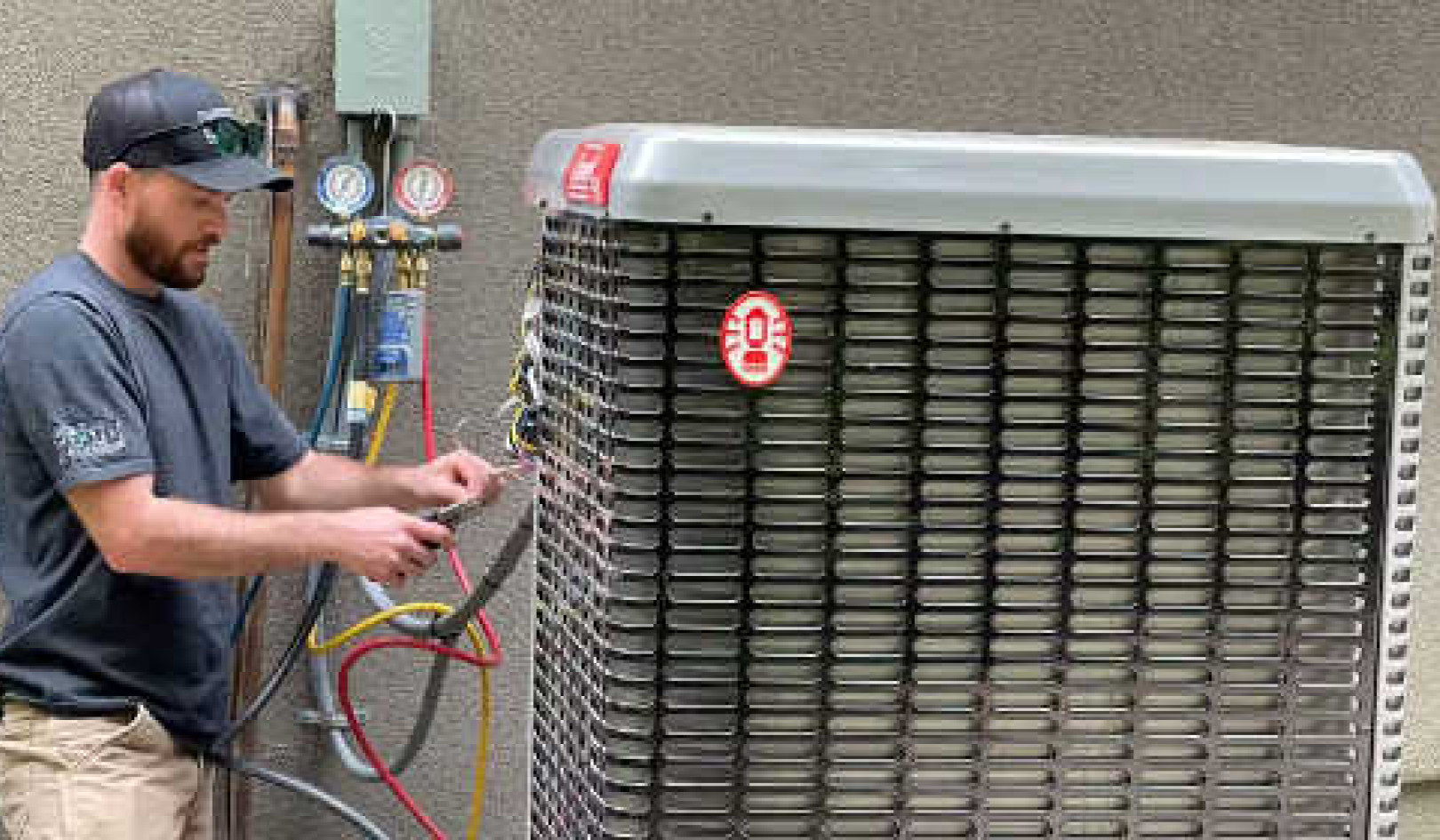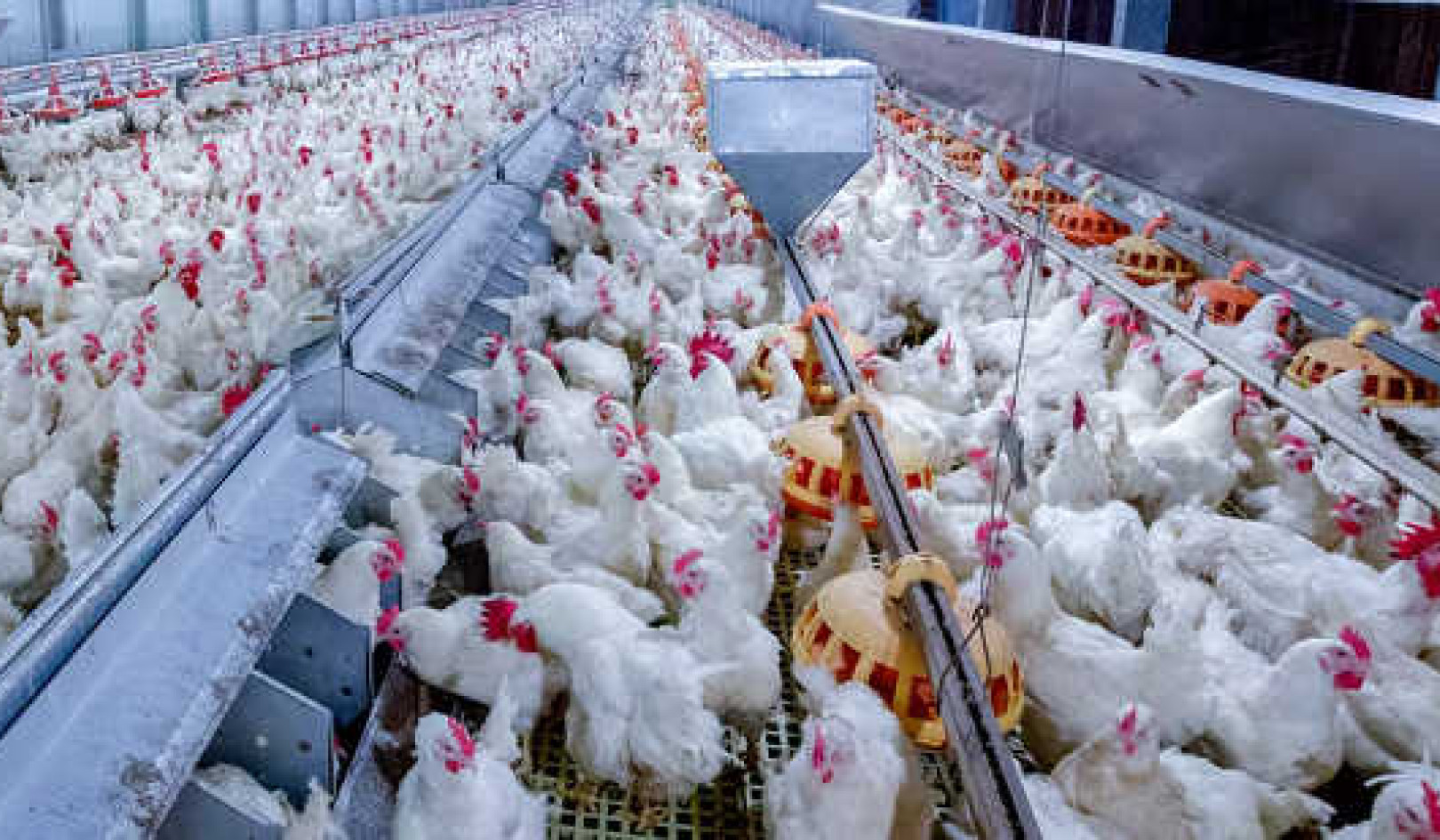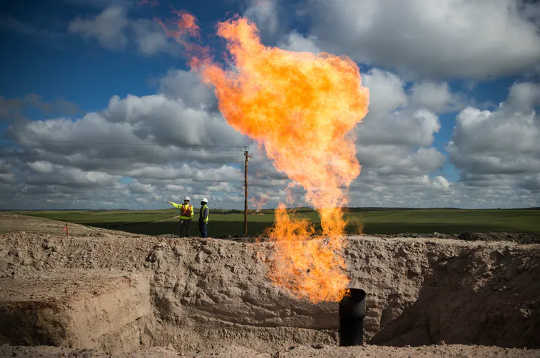 Flaring gas at an oil production site outside Williston, North Dakota. Andrew Burton/Getty Images
Flaring gas at an oil production site outside Williston, North Dakota. Andrew Burton/Getty Images
If you’ve driven through an area where companies extract oil and gas from shale formations, you’ve probably seen flames dancing at the tops of vertical pipes. That’s flaring – the mostly uncontrolled practice of burning off a byproduct of oil and gas production. Over the past 10 years, the U.S. shale oil and gas boom has made this country one of the world’s top five flaring nations, just behind Russia, Iran and Iraq.
It’s a dubious distinction. Routine flaring gives the industry a black eye.
I am an atmospheric scientist studying trace gases – chemicals that make up a small fraction of Earth’s atmosphere, but can have significant effects on the environment and human health. In several recent studies with graduate and undergraduate students, I have shown how routine flaring is inaccurately assessed and creates a sizable source of air pollution.
Due to a rapid oil price drop in the spring of 2020, new oil exploration has plummeted and production is running at reduced levels. But the industry can rapidly resume activities as demand and prices recover. And so will flaring.
Regulatory agencies, under pressure from environmental groups and parts of the industry, are finally considering rules to curb flaring. But can this wasteful and polluting practice be stopped?
Economic expediency
Each operating shale oil well produces variable amounts of “associated” or “casinghead” gas, a raw gas mixture of highly volatile hydrocarbons, mostly methane. Producers often don’t want this gas unless it can be collected through an existing network of pipelines.
Even when that’s possible, they may decide to dispose of the gas anyway because the cost of collecting and moving it can initially be higher than the value of the gas. This is where flaring comes in.
Routine flaring is common in the Bakken shale formation in North Dakota, the Eagle Ford shale in south-central Texas and the Permian Basin in northwest Texas and New Mexico. Texas has flared about as much gas annually as all of its residential users consume. In the Permian Basin alone, about US$750 million worth of gas was wasted in 2018, without any public benefit.
{vembed Y=y4eDlG9U25c}
In the Permian Basin region of west Texas, residents say gas flaring is polluting the air and making them sick.
At the same time, gas flaring contributes approximately 1% of man-made atmospheric carbon dioxide emissions globally. That is when flares combust hydrocarbons efficiently, converting them to carbon dioxide. In contrast, when flares burn poorly or go out, they pollute the air with more harmful gases.
Our studies in two regions of the Eagle Ford shale in Texas showed that flares may be the dominant source of nitrogen oxides, or NOx in these rural areas. NOx emissions contribute to acid rain, ozone and smog formation, and can irritate the eyes, nose, throat and lungs.
We found that at the sites we studied, industrial combustion sources such as flares produced about 10 times more NOx than cars in the area. Although a single flare may be a relatively small source, the large number of flares and high variability of NOx production per flare can cause large-scale atmospheric impacts visible from space.
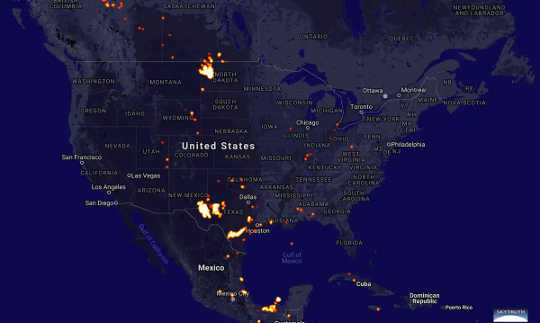 The nonprofit Skytruth posts time series views of gas flares seen from space, from 2012 to the present. Above, how flares looked in mid-July 2020. Skytruth.org
The nonprofit Skytruth posts time series views of gas flares seen from space, from 2012 to the present. Above, how flares looked in mid-July 2020. Skytruth.org
Unauthorized venting may explain high flaring volumes
Almost all flares are open combustion sources. They can be detected from space as bright, fixed-location heat radiation sources. Scientists have developed algorithms to catalog this radiant heat and relate it to the reported volume of gas flared globally.
With the help of undergraduate students, sociologist Kate Willyard and I evaluated data from the satellite-based Visible Infrared Imaging Radiometer, or VIIRS. We calculated flaring volumes in the two Texas shale oil production regions, both on a per-wellpad and per-county basis. We then compared it to a database from the Texas Railroad Commission, which regulates oil and gas production, for the years 2012-2015, and found large discrepancies between the two datasets.
In total, the volumes reported in the state database were only around half of what the satellite observed. Another, less detailed bulk analysis by the research firm S&P Global found similar discrepancies for shale regions in New Mexico and North Dakota.
These large differences may be explained by reporting errors and by several flare operations that are simply exempted from volume reporting. But we suspect that there is an even more systemic, mundane explanation: venting – the direct release of raw gas to the atmosphere.
Venting gas is allowed only for a small set of operations in the industry if it can be done safely. It is usually prohibited because it emits hydrocarbons, including air toxics such as benzene that can cause cancer, birth defects or other serious health problems.
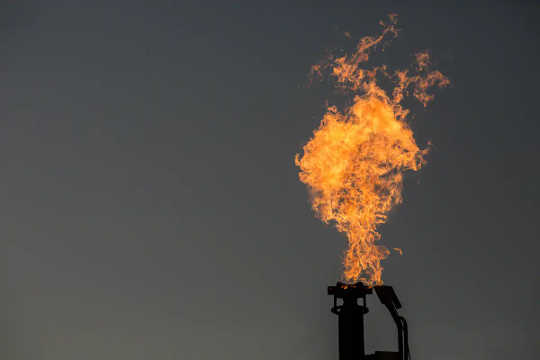 A natural gas flare burns at dusk in the Permian Basin in Texas. Bronte Wittpenn/Bloomberg via Getty Images
A natural gas flare burns at dusk in the Permian Basin in Texas. Bronte Wittpenn/Bloomberg via Getty Images
But venting mainly emits methane, which contributes to global warming and atmospheric ozone formation. Venting from flare stacks is illegal, since the flare is considered a waste treatment facility, but the practice apparently has increased over time.
Recent, higher-resolution satellite measurements of atmospheric methane over the Permian basin reveal that its emissions must be significantly higher than what is routinely reported to the Environmental Protection Agency, exceeding 3% of production instead of the more typically assumed 1-2%. Extra methane illegally vented through flare stacks would end up in the Texas Railroad Commission’s database, but satellites looking for heat radiation from combustion would not detect it.
[Deep knowledge, daily. Sign up for The Conversation’s newsletter.]
That heat radiation is converted into flaring volumes, using total reported volumes to agencies nationwide. But if a much smaller volume is actually flared, with some of the gas not combusted but vented, the satellite data would overestimate flaring. This is a problem because scientists and the World Bank’s zero flaring initiative employ these satellite-based flaring estimates.
Investors say flaring can be avoided
For a decade conservation groups such as the Environmental Defense Fund have called on regulators to address the shale industry’s methane emissions and the rapid increase in flaring. The Obama administration adopted a new rule in 2016 to curb methane leaks and reduce flaring on public and Indian lands. Now the Trump administration is trying to undo this action, albeit with limited success.
More to come in battle over regulating methane emissions/#flaring, #Wyoming court lifted a stay on 2016 lawsuit against the Obama-era Waste Prevention Rule. Came just days after a Cali judge vacated Trump administration replacement to methane regs. The plot thickens. #energy pic.twitter.com/NbSWHLxwok
— Camille S. Erickson (@camillereports) July 24, 2020
Meanwhile, a new study commissioned by the Environmental Defense Fund and involving investors concludes that there are feasible and cost-effective ways for oil and gas companies to minimize flaring even without much regulation. Nevertheless, given that much of the industry has already spent a decade without widely employing such best-practice measures, I expect that oil and gas companies are likely to keep wasting and polluting for the foreseeable future unless government agencies impose tighter regulations.![]()
About The Author
Gunnar W. Schade, Associate Professor of Atmospheric Sciences, Texas A&M University
This article is republished from The Conversation under a Creative Commons license. Read the original article.
Related Books
Drawdown: The Most Comprehensive Plan Ever Proposed to Reverse Global Warming
by Paul Hawken and Tom Steyer In the face of widespread fear and apathy, an international coalition of researchers, professionals, and scientists have come together to offer a set of realistic and bold solutions to climate change. One hundred techniques and practices are described here—some are well known; some you may have never heard of. They range from clean energy to educating girls in lower-income countries to land use practices that pull carbon out of the air. The solutions exist, are economically viable, and communities throughout the world are currently enacting them with skill and determination. Available On Amazon
In the face of widespread fear and apathy, an international coalition of researchers, professionals, and scientists have come together to offer a set of realistic and bold solutions to climate change. One hundred techniques and practices are described here—some are well known; some you may have never heard of. They range from clean energy to educating girls in lower-income countries to land use practices that pull carbon out of the air. The solutions exist, are economically viable, and communities throughout the world are currently enacting them with skill and determination. Available On Amazon
Designing Climate Solutions: A Policy Guide for Low-Carbon Energy
by Hal Harvey, Robbie Orvis, Jeffrey Rissman With the effects of climate change already upon us, the need to cut global greenhouse gas emissions is nothing less than urgent. It’s a daunting challenge, but the technologies and strategies to meet it exist today. A small set of energy policies, designed and implemented well, can put us on the path to a low carbon future. Energy systems are large and complex, so energy policy must be focused and cost-effective. One-size-fits-all approaches simply won’t get the job done. Policymakers need a clear, comprehensive resource that outlines the energy policies that will have the biggest impact on our climate future, and describes how to design these policies well. Available On Amazon
With the effects of climate change already upon us, the need to cut global greenhouse gas emissions is nothing less than urgent. It’s a daunting challenge, but the technologies and strategies to meet it exist today. A small set of energy policies, designed and implemented well, can put us on the path to a low carbon future. Energy systems are large and complex, so energy policy must be focused and cost-effective. One-size-fits-all approaches simply won’t get the job done. Policymakers need a clear, comprehensive resource that outlines the energy policies that will have the biggest impact on our climate future, and describes how to design these policies well. Available On Amazon
This Changes Everything: Capitalism vs. The Climate
by Naomi Klein In This Changes Everything Naomi Klein argues that climate change isn’t just another issue to be neatly filed between taxes and health care. It’s an alarm that calls us to fix an economic system that is already failing us in many ways. Klein meticulously builds the case for how massively reducing our greenhouse emissions is our best chance to simultaneously reduce gaping inequalities, re-imagine our broken democracies, and rebuild our gutted local economies. She exposes the ideological desperation of the climate-change deniers, the messianic delusions of the would-be geoengineers, and the tragic defeatism of too many mainstream green initiatives. And she demonstrates precisely why the market has not—and cannot—fix the climate crisis but will instead make things worse, with ever more extreme and ecologically damaging extraction methods, accompanied by rampant disaster capitalism. Available On Amazon
In This Changes Everything Naomi Klein argues that climate change isn’t just another issue to be neatly filed between taxes and health care. It’s an alarm that calls us to fix an economic system that is already failing us in many ways. Klein meticulously builds the case for how massively reducing our greenhouse emissions is our best chance to simultaneously reduce gaping inequalities, re-imagine our broken democracies, and rebuild our gutted local economies. She exposes the ideological desperation of the climate-change deniers, the messianic delusions of the would-be geoengineers, and the tragic defeatism of too many mainstream green initiatives. And she demonstrates precisely why the market has not—and cannot—fix the climate crisis but will instead make things worse, with ever more extreme and ecologically damaging extraction methods, accompanied by rampant disaster capitalism. Available On Amazon
From The Publisher:
Purchases on Amazon go to defray the cost of bringing you InnerSelf.comelf.com, MightyNatural.com, and ClimateImpactNews.com at no cost and without advertisers that track your browsing habits. Even if you click on a link but don't buy these selected products, anything else you buy in that same visit on Amazon pays us a small commission. There is no additional cost to you, so please contribute to the effort. You can also use this link to use to Amazon at any time so you can help support our efforts.





















